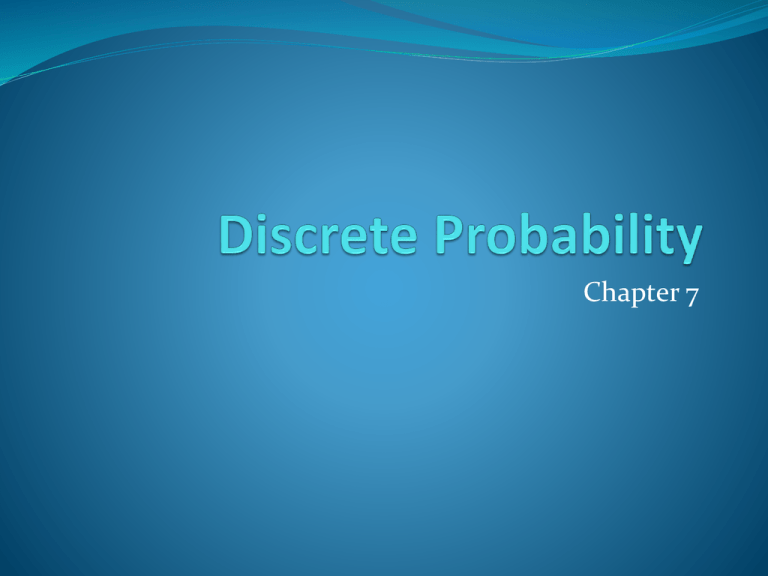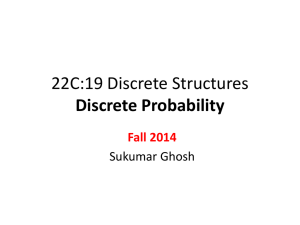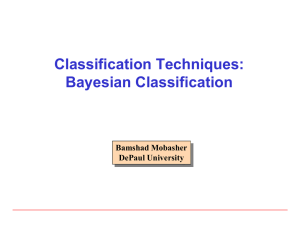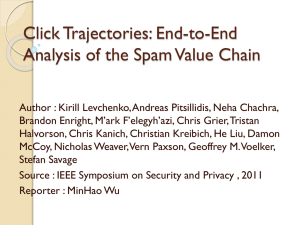Document
advertisement

Chapter 7
Chapter Summary
Introduction to Discrete Probability
Probability Theory
Bayes’ Theorem
Section 7.1
Section Summary
Finite Probability
Probabilities of Complements and Unions of Events
Probability of an Event
Pierre-Simon Laplace
(1749-1827)
We first study Laplace’s classical theory of probability, which he
introduced in the 18th century, when he analyzed games of
chance.
We define these key terms:
An experiment is a procedure that yields one of a given set of
possible outcomes.
The sample space of the experiment is the set of possible
outcomes.
An event is a subset of the sample space.
Definition: If S is a finite sample space of equally likely
outcomes, and E is an event, that is, a subset of S, then the
probability of E is p(E) = |E|/|S|.
For every event E, we have 0 ≤ p(E) ≤ 1. This follows directly
from the definition because 0 ≤ p(E) = |E|/|S| ≤ |S|/|S| ≤ 1,
since 0 ≤ |E| ≤ |S|.
Applying Laplace’s Definition
Example: An urn contains four blue balls and five red
balls. What is the probability that a ball chosen from
the urn is blue?
Example: What is the probability that when two dice
are rolled, the sum of the numbers on the two dice is
7?
Applying Laplace’s Definition
Example: An urn contains four blue balls and five red balls.
What is the probability that a ball chosen from the urn is
blue?
Solution: The probability that the ball is chosen is 4/9
since there are 9 possible outcomes, and 4 of these produce
a blue ball.
Example: What is the probability that when two dice are
rolled, the sum of the numbers on the two dice is 7?
Solution: By the product rule there are 62 = 36 possible
outcomes. Six of these sum to 7. Hence, the probability of
obtaining a 7 is 6/36 = 1/6.
Applying Laplace’s Definition
Example: In a lottery, a player wins a large prize when
they pick four digits that match, in correct order, four
digits selected by a random mechanical process
(repeats are allowed). What is the probability that a
player wins the prize?
A smaller prize is won if only three digits are matched.
What is the probability that a player wins the small
prize?
Applying Laplace’s Definition
Example: In a lottery, a player wins a large prize when they pick four digits that
match, in correct order, four digits selected by a random mechanical process
(repeats are allowed). What is the probability that a player wins the prize?
Solution: By the product rule there are 10^4 = 10,000 ways to pick four digits.
Since there is only 1 way to pick the correct digits, the probability of winning
the large prize is 1/10,000 = 0.0001.
A smaller prize is won if only three digits are matched. What is the probability
that a player wins the small prize?
Solution: If exactly three digits are matched, one of the four digits must be
incorrect and the other three digits must be correct. For the digit that is
incorrect, there are 9 possible choices (all except the correct digit).
The digit that is incorrect can be in any of 4 positions. Hence, by the sum rule,
there a total of 36 possible ways to choose four digits that match exactly three
of the winning four digits. The probability of winning the small price is
36/10,000 = 9/2500 = 0.0036.
Applying Laplace’s Definition
Example: There are many lotteries that award prizes
to people who correctly choose a set of six numbers out
of the first n positive integers, where n is usually
between 30 and 60. What is the probability that a
person picks the correct six numbers out of 40?
Applying Laplace’s Definition
Example: There are many lotteries that award prizes to
people who correctly choose a set of six numbers out of the
first n positive integers, where n is usually between 30 and
60. What is the probability that a person picks the correct
six numbers out of 40?
Solution: The number of ways to choose six numbers out
of 40 is
C(40,6) = 40!/(34!6!) = 3,838,380.
There is only one winning combination.
Hence, the probability of picking a winning combination is
1/ 3,838,380 ≈ 0.00000026.
Can you work out the probability of winning the lottery with
the biggest prize where you live?
Applying Laplace’s Definition
Example: What is the probability that the numbers
11, 4, 17, 39, and 23 are drawn in that order from a bin
with 50 balls labeled with the numbers 1,2, …, 50 if
a) The ball selected is not returned to the bin.
b) The ball selected is returned to the bin before the next
ball is selected.
Applying Laplace’s Definition
Example: What is the probability that the numbers 11, 4,
17, 39, and 23 are drawn in that order from a bin with 50
balls labeled with the numbers 1,2, …, 50 if
The ball selected is not returned to the bin.
b) The ball selected is returned to the bin before the next ball
is selected.
a)
Solution: Use the product rule in each case.
a)
Sampling without replacement: The probability is
1/254,251,200 since there are 50 ∙49 ∙ 48 .47 ∙46 = P(50, 5)
=254,251,200 ways to choose the five balls.
b) Sampling with replacement: The probability is
1/505 = 1/312,500,000 since 505 = 312,500,000.
The Probability of Complements
and Unions of Events
Theorem 1: Let E be an event in sample space S. The
probability of the event = S − E, the complementary
event of E, is given by
Proof: Using the fact that | | = |S| − |E|,
The Probability of Complements
and Unions of Events
Example: A sequence of 10 bits is chosen randomly.
What is the probability that at least one of these bits is
0?
Solution: Let E be the event that at least one of the 10
bits is 0. Then is the event that all of the bits are 1s.
The size of the sample space S is 210. Hence,
The Probability of Complements
and Unions of Events
Theorem 2: Let E1 and E2 be events in the sample
space S. Then
Proof: Given the inclusion-exclusion formula from
Section 2.2, |A ∪ B| = |A| + | B| − |A ∩ B|, it follows
that
The Probability of Complements
and Unions of Events
Example: What is the probability that a positive
integer selected at random from the set of positive
integers not exceeding 100 is divisible by either 2 or 5?
Solution: Let E1 be the event that the integer is
divisible by 2 and E2 be the event that it is divisible 5?
Then the event that the integer is divisible by 2 or 5 is
E1 ∪ E2 and E1 ∩ E2 is the event that it is divisible by 2
and 5.
It follows that:
p(E1 ∪ E2) = p(E1) + p(E2) – p(E1 ∩ E2)
= 50/100 + 20/100 − 10/100 = 3/5.
1
2
3
Monty Hall Puzzle
Example: You are asked to select one of the three
doors to open. There is a large prize behind one of the
doors and if you select that door, you win the prize.
After you select a door, the game show host opens one
of the other doors (which he knows is not the winning
door). The prize is not behind the door and he gives
you the opportunity to switch your selection. Should
you switch?
1
2
3
Monty Hall Puzzle
Example: You are asked to select one of the three doors to open.
There is a large prize behind one of the doors and if you select
that door, you win the prize. After you select a door, the game
show host opens one of the other doors (which he knows is not
the winning door). The prize is not behind the door and he gives
you the opportunity to switch your selection. Should you switch?
(This is a notoriously confusing problem that has been the subject of much
discussion . Do a web search to see why!)
Solution: You should switch. The probability that your initial
pick is correct is 1/3. This is the same whether or not you switch
doors.
Since the game show host always opens a door that does not have
the prize, if you switch the probability of winning will be 2/3,
because you win if your initial pick was not the correct door and
the probability your initial pick was wrong is 2/3.
Section 7.2
Section Summary
Assigning Probabilities
Probabilities of Complements and Unions of Events
Conditional Probability
Independence
Bernoulli Trials and the Binomial Distribution
Assigning Probabilities
Laplace’s definition from the previous section, assumed
that all outcomes were equally likely. Now we introduce a
more general definition of probabilities that avoids this
restriction.
Let S be a sample space of an experiment with a finite
number of outcomes. We assign a probability p(s) to each
outcome s, so that:
i.
0 ≤ p(s) ≤ 1 for each s S
ii.
The function p from the set of all outcomes of the sample
space S is called a probability distribution.
Assigning Probabilities
Example: What probabilities should we assign to the
outcomes H (heads) and T (tails) when a fair coin is
flipped? What probabilities should be assigned to
these outcomes when the coin is biased so that heads
comes up twice as often as tails?
Solution:
For the biased coin, we have p(H) = 2p(T).
Because p(H) + p(T) = 1, it follows that
2p(T) + p(T) = 3p(T) = 1.
Hence, p(T) = 1/3 and p(H) = 2/3.
Uniform Distribution
Definition: Suppose that S is a set with n elements.
The uniform distribution assigns the probability 1/n to
each element of S. (Note that we could have used
Laplace’s definition here.)
Example: Consider again the coin flipping example,
but with a fair coin. Now p(H) = p(T) = 1/2.
Probability of an Event
Definition: The probability of the event E is the sum
of the probabilities of the outcomes in E.
Note that now no assumption is being made about the
distribution.
Example
Example: Suppose that a die is biased so that 3
appears twice as often as each other number, but that
the other five outcomes are equally likely. What is the
probability that an odd number appears when we roll
this die?
Solution: We want the probability of the event
E = {1,3, 5}. We have p(3) = 2/7 and
p(1) = p(2) = p(4) = p(5) = p(6) = 1/7.
Hence, p(E) = p(1) + p(3) + p(5) =
1/7 + 2/7 + 1/7 = 4/7.
Probabilities of Complements and
Unions of Events
Complements:
each outcome is in either E or
still holds. Since
, but not both,
Unions:
also still holds under the new definition.
Combinations of Events
Theorem: If E1, E2, … is a sequence of pairwise disjoint
events in a sample space S, then
see Exercises 36 and 37 for the proof
Conditional Probability
Definition: Let E and F be events with p(F) > 0. The conditional
probability of E given F, denoted by P(E|F), is defined as:
Example: A bit string of length four is generated at random so
that each of the 16 bit strings of length 4 is equally likely. What
is the probability that it contains at least two consecutive 0s,
given that its first bit is a 0?
Solution: Let E be the event that the bit string contains at least
two consecutive 0s, and F be the event that the first bit is a 0.
Since E ⋂ F = {0000, 0001, 0010, 0011, 0100}, p(E⋂F)=5/16.
Because 8 bit strings of length 4 start with a 0, p(F) = 8/16= ½.
Hence,
Conditional Probability
Example: What is the conditional probability that a
family with two children has two boys, given that they
have at least one boy. Assume that each of the
possibilities BB, BG, GB, and GG is equally likely where
B represents a boy and G represents a girl.
Conditional Probability
Example: What is the conditional probability that a
family with two children has two boys, given that they
have at least one boy. Assume that each of the
possibilities BB, BG, GB, and GG is equally likely where
B represents a boy and G represents a girl.
Solution: Let E be the event that the family has two
boys and let F be the event that the family has at least
one boy. Then E = {BB}, F = {BB, BG, GB}, and
E ⋂ F = {BB}.
It follows that p(F) = 3/4 and p(E⋂F)=1/4.
Hence,
Independence
Two events are independent if the occurrence of one of
the events gives us no information about whether or
not the other event will occur; that is, the events have
no influence on each other.
In probability theory we say that two events, E and F,
are independent if the probability that they both occur
is equal to the product of the probabilities of the two
individual events
Independence
Definition: The events E and F are independent if and
only if
p(E⋂F) = p(E)p(F).
Note that if E and F are independent events then
P(E/F) = P(E) and P(F/E) = P(F)
The conditional probability of E happening, given that F
has happened, is exactly the same as the probability of E.
E is not affected by F.
Independence
Definition: The events E and F are independent if and only if
p(E⋂F) = p(E)p(F).
Example: Suppose E is the event that a randomly generated bit string
of length four begins with a 1 and F is the event that this bit string
contains an even number of 1s. Are E and F independent if the 16 bit
strings of length four are equally likely?
Solution: There are eight bit strings of length four that begin with a 1,
and eight bit strings of length four that contain an even number of 1s.
Since the number of bit strings of length 4 is 16,
p(E) = p(F) = 8/16 = ½.
Since E⋂F = {1111, 1100, 1010, 1001}, p(E⋂F) = 4/16=1/4.
We conclude that E and F are independent, because
p(E⋂F) =1/4 = (½) (½)= p(E) p(F)
Gambler’s Fallacy
Gambler’s Falacy = The belief that if deviations from expected
behaviour are observed in repeated independent trials of some
random process, then future deviations in the opposite direction
are more likely.
Fair coin tossing: The probability of getting heads in a toss is ½
The probability of getting 3 heads in a row is 1/8
Suppose we tossed 4 heads in a row. What is the probability that
the 5th toss is a head?
A believer in Gambler’s Falacy may think the less toss is more
likely to be a tail. However, this is not true.
P(A5 | A1 & A2 & A3 & A4) = P(A5) = ½
The events “five heads in a row” and “four heads then tails” are
equally likely, with probability 1/32.
Why the probability is ½ for a fair
coin
We saw that, if one flips a fair coin 21 times, then the
probability of 21 heads is 1 in 2,097,152.
However, the probability of flipping a head after
having already flipped 20 heads in a row is simply 1⁄2.
Independence
Example: Assume (as in the previous example) that
each of the four ways a family can have two children
(BB, GG, BG,GB) is equally likely. Are the events E, that
a family with two children has two boys, and F, that a
family with two children has at least one boy,
independent?
Solution: Because E = {BB}, p(E) = 1/4. We saw
previously that that p(F) = 3/4 and p(E⋂F)=1/4. The
events E and F are not independent since
p(E) p(F) = 3/16 ≠ 1/4= p(E⋂F) .
Pairwise and Mutual Independence
Definition: The events E1, E2, …, En are pairwise
independent if and only if p(Ei⋂Ej) = p(Ei) p(Ej) for all
pairs i and j with i ≤ j ≤ n.
The events are mutually independent if
whenever ij, j = 1,2,…., m, are integers with
1 ≤ i1 < i2 <∙∙∙ < im ≤ n and m ≥ 2.
James Bernoulli
(1654 – 1705)
Bernoulli Trials
Definition: Suppose an experiment can have only two
possible outcomes, e.g., the flipping of a coin or the
random generation of a bit.
Each performance of the experiment is called a Bernoulli trial.
One outcome is called a success and the other a failure.
If p is the probability of success and q the probability of
failure, then p + q = 1.
Many problems involve determining the probability of k
successes when an experiment consists of n mutually
independent Bernoulli trials.
Bernoulli Trials
Example: A coin is biased so that the probability of heads is 2/3.
What is the probability that exactly four heads occur when the
coin is flipped seven times?
Solution:
The number of ways four of the seven flips can be heads is
C(7,4), so there are C(7,4) successes. The probability of their
union is the sum of the probabilities for each success, since the
events are disjoint.
The probability of each of the successes is (2/3)4(1/3)3, since the
seven flips are independent events.
Hence, the probability that exactly four heads occur is
C(7,4) (2/3)4(1/3)3 = (35∙ 16)/ 37 = 560/ 2187.
Probability of k Successes in n
Independent Bernoulli Trials.
Theorem 2: The probability of exactly k successes in n independent
Bernoulli trials, with probability of success p and probability of failure
q = 1 − p, is
C(n,k) pk qn−k
Proof: The outcome of n Bernoulli trials is an n-tuple (t1,t2,…,tn),
where each is ti either S (success) or F (failure). The probability of each
outcome of n trials consisting of k successes and n− k failures (in any
order) is pkqn−k. Because there are C(n,k) n-tuples of Ss and Fs that
contain exactly k Ss, the probability of k successes is C(n,k)pkqn−k.
We denote by b(k:n,p) the probability of k successes in n independent
Bernoulli trials with p the probability of success. Viewed as a function
of k, b(k:n,p) is the binomial distribution. By Theorem 2,
b(k:n,p) = C(n,k)pkqn−k.
Binomial distribution for various p
Section 7.3
Section Summary
Bayes’ Theorem
Generalized Bayes’ Theorem
Bayesian Spam Filters
Motivation for Bayes’ Theorem
Bayes’ theorem allows us to use probability to answer
questions such as the following:
Given that someone tests positive for having a particular
disease, what is the probability that they actually do
have the disease?
Given that someone tests negative for the disease, what
is the probability, that in fact they do have the disease?
Bayes’ theorem has applications to medicine, law,
artificial intelligence, engineering, and many diverse
other areas.
Thomas Bayes
(1702-1761)
Bayes’ Theorem
Bayes’ Theorem: Suppose that E and F are events from a sample
space S such that p(E)≠ 0 and p(F) ≠ 0. Then:
Example: We have two boxes. The first box contains two green
balls and seven red balls. The second contains four green balls
and three red balls. Bob selects one of the boxes at random. Then
he selects a ball from that box at random. If he has a red ball,
what is the probability that he selected a ball from the first box.
Let E be the event that Bob has chosen a red ball and F be the event
that Bob has chosen the first box.
By Bayes’ theorem the probability that Bob has picked the first box
is:
Proof of Bayes’ Theorem
Recall the definition of the conditional probability
p(E|F):
From this definition, it follows that:
,
continued →
Proof of Bayes’ Theorem
On the last slide we showed that
,
Equating the two formulas
for p(E F) shows that
Solving for p(E|F) and for p(F|E) tells us that
,
continued →
Proof of Bayes’ Theorem
On the last slide we
showed that:
Note that
since
because
and
By the definition of conditional probability,
Hence,
Applying Bayes’ Theorem
Example: Suppose that one person in 100,000 has a
particular disease. There is a test for the disease that
gives a positive result 99% of the time when given to
someone with the disease. When given to someone
without the disease, the test gives a negative result
99.5% of the time. Find:
the probability that a person who test positive has the
disease.
b) the probability that a person who test negative does
not have the disease.
a)
Should someone who tests positive be worried?
Applying Bayes’ Theorem
Solution: Let D be the event that the person has the
disease, and E be the event that this person tests
positive. We need to compute p(D|E) from p(D),
p(E|D), p( E | ), p( ).
Can you use this formula
to explain why the
resulting probability is
surprisingly small?
So, don’t worry too much, if your test
for this disease comes back positive.
Applying Bayes’ Theorem
What if the result is negative?
So, the probability you
have the disease if you
test negative is
So, it is extremely unlikely you have the disease if you test
negative.
Generalized Bayes’ Theorem
Generalized Bayes’ Theorem: Suppose that E is an
event from a sample space S and that F1, F2, …, Fn are
mutually exclusive events such that
Assume that p(E) ≠ 0 for i = 1, 2, …, n. Then
Exercise 17 asks for the proof.
Bayesian Spam Filters
How do we develop a tool for determining whether an
email is likely to be spam?
If we have an initial set B(ad) of spam messages and set
G(ood) of non-spam messages. We can use this
information along with Bayes’ law to predict the probability
that a new email message is spam.
We look at a particular word w, and count the number of
times that it occurs in B and in G; nB(w) and nG(w).
Empirical probability that an email containing w is spam:
p(w) = nB(w)/|B|
Empirical probability that an email containing w is not spam:
q(w) = nG(w)/|G|
continued →
Bayesian Spam Filters
Let S be the event that the message is spam, and E be
the event that the message contains the word w.
Using Bayes’ Rule,
Assuming that it is
equally likely that an
arbitrary message is
spam and is not
spam; i.e., p(S) = ½.
Using our
empirical
estimates of
p(E | S) and
p(E |`S).
Note: If we have data on the
frequency of spam messages,
we can obtain a better
estimate for p(s).
(See Exercise 22.)
r(w) estimates the probability that the
message is spam. We can class the message
as spam if r(w) is above a threshold we
decide on apriori, such as 0.9.
Bayesian Spam Filters
Example: We find that the word “Rolex” occurs in 250
out of 2000 spam messages and occurs in 5 out of 1000
non-spam messages. Estimate the probability that an
incoming message containing the word “Rolex” is
spam, if the threshold for rejecting the email is 0.9.
Solution: p(Rolex) = 250/2000 =.0125 and
q(Rolex) = 5/1000 = 0.005.
We class the message as spam and
reject the email!
Bayesian Spam Filters using Multiple Words
Accuracy can be improved by considering more than
one word as evidence.
Consider the case where E1 and E2 denote the events
that the message contains the words w1 and w2
respectively.
We make the simplifying assumption that the events
are independent. And again we assume that p(S) = ½.
Bayesian Spam Filters using Multiple Words
Example: We have 2000 spam messages and 1000 non-spam
messages. The word “stock” occurs in 400 spam messages and in 60
non-spam messages. The word “undervalued” occurs in 200 spam
and 25 non-spam messages. Should we reject as spam message that
contains both “stock” and “undervalued”, if the threshold is set to 0.9?
Solution: p(stock) = 400/2000 = .2, q(stock) = 60/1000=.06,
p(undervalued) = 200/2000 = .1, q(undervalued) = 25/1000 = .025
If our threshold is .9, we class the message as spam and reject it.
Bayesian Spam Filters using Multiple Words
In general, the more words we consider, the more
accurate the spam filter. With the independence
assumption if we consider k words:
We can further improve the filter by considering pairs of words
as a single block or certain types of strings.







